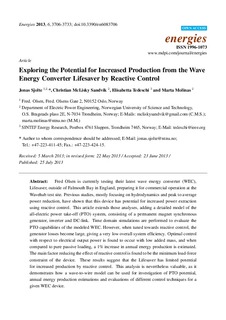| dc.contributor.author | Sjolte, Jonas | |
| dc.contributor.author | Sandvik, Christian Mclisky | |
| dc.contributor.author | Tedeschi, Elisabetta | |
| dc.contributor.author | Molinas Cabrera, Maria Marta | |
| dc.date.accessioned | 2015-09-30T07:46:15Z | |
| dc.date.accessioned | 2015-11-19T10:07:18Z | |
| dc.date.available | 2015-09-30T07:46:15Z | |
| dc.date.available | 2015-11-19T10:07:18Z | |
| dc.date.issued | 2013 | |
| dc.identifier.citation | Energies 2013, 6(8): 3706-3733 | nb_NO |
| dc.identifier.issn | 1996-1073 | |
| dc.identifier.uri | http://hdl.handle.net/11250/2364726 | |
| dc.description.abstract | Fred Olsen is currently testing their latest wave energy converter (WEC), Lifesaver, outside of Falmouth Bay in England, preparing it for commercial operation at the Wavehub test site. Previous studies, mostly focusing on hydrodynamics and peak to average power reduction, have shown that this device has potential for increased power extraction using reactive control. This article extends those analyses, adding a detailed model of the all-electric power take-off (PTO) system, consisting of a permanent magnet synchronous generator, inverter and DC-link. Time domain simulations are performed to evaluate the PTO capabilities of the modeled WEC. However, when tuned towards reactive control, the generator losses become large, giving a very low overall system efficiency. Optimal control with respect to electrical output power is found to occur with low added mass, and when compared to pure passive loading, a 1% increase in annual energy production is estimated. The main factor reducing the effect of reactive control is found to be the minimum load-force constraint of the device. These results suggest that the Lifesaver has limited potential for increased production by reactive control. This analysis is nevertheless valuable, as it demonstrates how a wave-to-wire model can be used for investigation of PTO potential, annual energy production estimations and evaluations of different control techniques for a given WEC device. | nb_NO |
| dc.language.iso | eng | nb_NO |
| dc.publisher | MDPI | nb_NO |
| dc.title | Exploring the Potential for Increased Production from the Wave Energy Converter Lifesaver by Reactive Control | nb_NO |
| dc.type | Journal article | nb_NO |
| dc.type | Peer reviewed | en_GB |
| dc.date.updated | 2015-09-30T07:46:15Z | |
| dc.source.pagenumber | 3706-3733 | nb_NO |
| dc.source.volume | 6 | nb_NO |
| dc.source.journal | Energies | nb_NO |
| dc.source.issue | 8 | nb_NO |
| dc.identifier.doi | 10.3390/en6083706 | |
| dc.identifier.cristin | 1047324 | |
| dc.relation.project | Norges forskningsråd: 212184 | nb_NO |
| dc.description.localcode | This is an open access article distributed under the Creative Commons Attribution License (CC BY) which permits unrestricted use, distribution, and reproduction in any medium, provided the original work is properly cited. | nb_NO |
